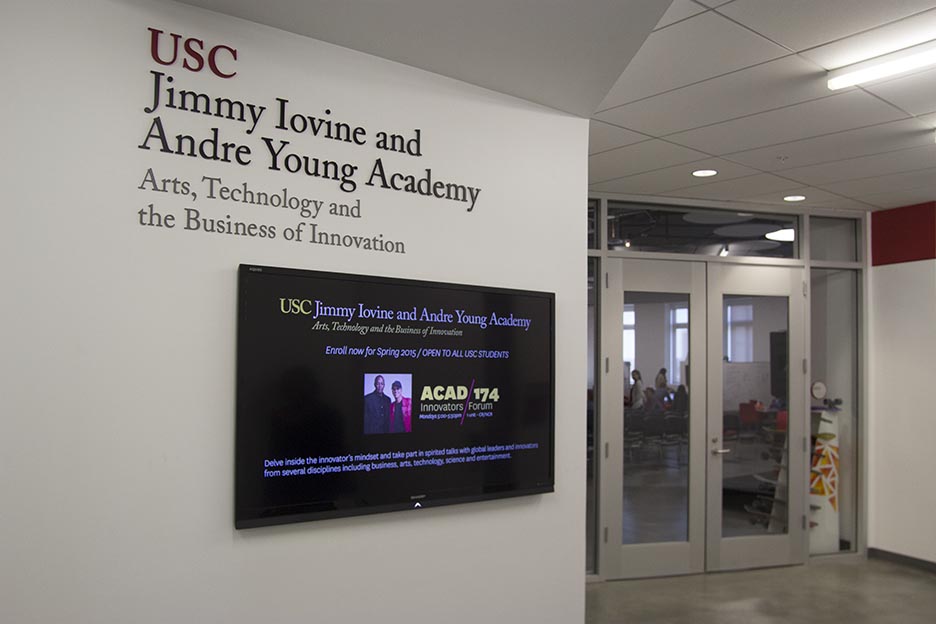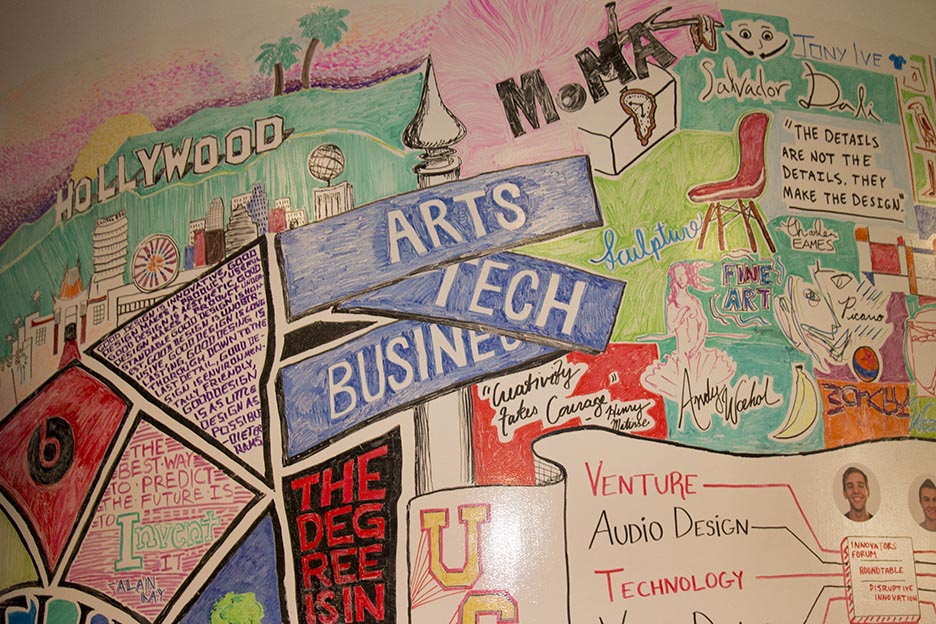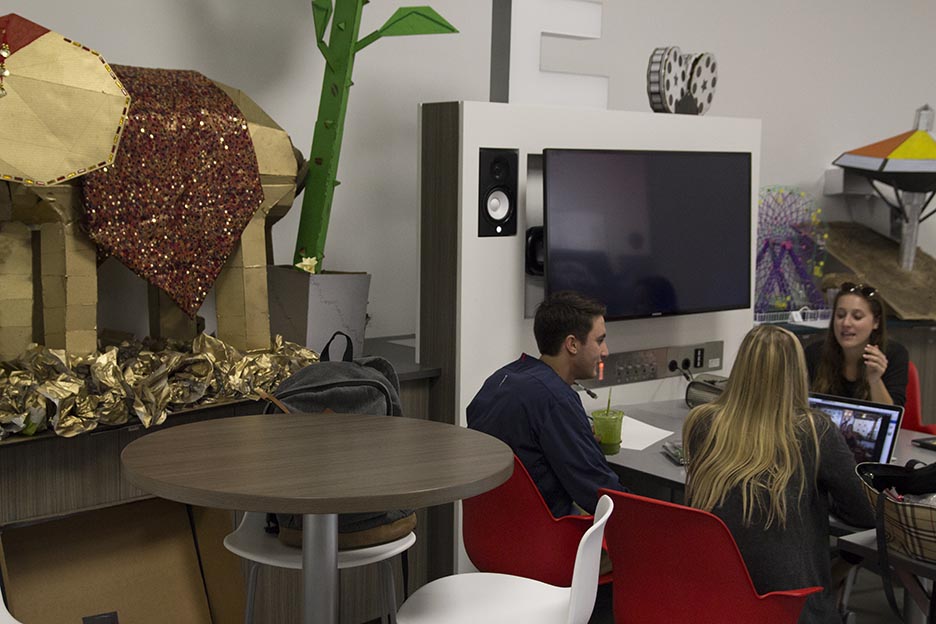 At the entrance to The Garage, the main workspace for students of the Iovine and Young Academy. (Vanessa Okoth-Obbo)
At the entrance to The Garage, the main workspace for students of the Iovine and Young Academy. (Vanessa Okoth-Obbo)
When the freshman class arrived at the University of Southern California’s new collaborative hub, 13 of them were on skateboards.
The high-tech workspace on the fourth floor of the Ronald Tutor Campus Center is equipped with 3D printers and widescreen televisions, but the students felt that there was still room for a personal touch.
“Why don’t we buy a skate rack, so that we don’t leave our boards on the ground?” one student asked.
“Well, why don’t we just build one?” another one answered. The prototype for a wooden skate rack was designed by the end of that week and it was constructed soon after.
This is exactly the type of enterprise that is encouraged at the Jimmy Iovine and Andre Young Academy for Arts, Technology and the Business of Innovation. The Academy welcomed its inaugural class on August 25, 2014. Its students represent 14 states as well as nations further afield like Russia and China.

Southern California is an increasingly attractive destination for those looking to launch new ventures. Northern California and Silicon Valley dominated the conversation about technology in the Golden State for several decades but SoCal witnessed the fastest rate of start-up creation in the first half of 2014, according to a study by Upfront Ventures. The Iovine and Young Academy offers a four-year Bachelor’s degree, designed to mold the next generation of innovators who will thrive in this fast-paced environment.
The Academy was established using a $70 million gift from Jimmy Iovine and Andre Young, also known as Dr. Dre. The duo is linked to every aspect of the new institution’s title, from the names that appear at the top down to the business. Young is a multiplatinum selling musician who came to the public’s attention as a member of the World Class Wreckin’ Cru and later N.W.A. Until recently Iovine was the head of Interscope Geffen A&M Records, but as a producer he has worked with the likes of U2, Bruce Springsteen and Lady Gaga.
The two joined forces to start Beats Electronics. The company specializes in software, music subscription services and high-end audio products including the popular Beats by Dr. Dre headphones which boast the ubiquitous red “b” logo.
Apple acquired Beats Electronics earlier this year for a reported $3 billion, portion of which was was used to launch the Academy. Its creative workspace, “The Garage,” which contains a classroom, meeting tables, widescreen displays, 3D printers and a workshop, was completed earlier this year.
After the funding and home base were secured, the next step was to figure out which inquiring minds would inhabit the new space.
“It was a fascinating experience,” said Assistant Dean Brian Shepard. “It was very demanding and a lot of time went into it … but I think we really got it right.”
Shepard is also a professor of audio design at USC. With almost 30 years of experience as an orchestral musician, he developed a love of technology through his involvement in the world of commercial music and audio recording. He played a key role in the program’s development as well as the selection process.
In addition to the Common Application, test scores, transcripts and a USC-specific supplemental essay, Academy hopefuls were encouraged to submit their creative portfolios. Then there was the proposal video. Each applicant was required to present a new idea, product or concept in the form of a one-minute long video pitch.
“We were not terribly concerned with what it was they were pitching, as much as the type of work that they put into it and the way they presented themselves,” Shepard explained.
Care and originality were expected but the remaining criteria for the video were defined loosely, leading to an exciting range of submissions. New York native Sarah Kassel seized the opportunity to sell the admissions committee on something they could certainly not find anywhere else.
“The assignment was to pitch a product, and I didn’t have [one] so I pitched myself as the product,” Kassel said. “I basically just talked right into my webcam. It was pretty low resolution but I think I really sold it,” she recalled.
Matt Stern, a student from nearby Manhattan Beach, already had a fully formed idea in mind. He founded a non-profit organization that unites high-school students to fundraise and build schoolhouses for students their age in foreign countries. He used his 60 seconds of screen time to discuss this work.
“I had just returned from living in Kenya for the summer and I had a 182 hours of logged footage,” he said. “I had more than I needed … and there was no more perfect idea than to cut a promo for my non-profit.”
 Academy students designed a "mind map" that adorns the main wall in the The Garage (Vanessa Okoth-Obbo)
Academy students designed a "mind map" that adorns the main wall in the The Garage (Vanessa Okoth-Obbo)
The admissions committee whittled down more than 300 applications to a solid 60. After a round of interviews, most in-person and some over Skype, the committee finished selecting the inaugural class.
Successful applicants were informed of their admissions via a personalized video featuring both Iovine and Dr. Dre. Although initial promotional material stated that the Academy only had 25 places available, there are currently 31 students enrolled.
The next challenge was to design a syllabus flexible enough to allow the program’s objectives to evolve in step with advances in technology.
“Our curriculum in general is a bit of a moving target,” said Assistant Dean Brian Shepard. “We’re trying to stay current with the latest trends and developments, so we can’t just create [one] that stays the same.”
The Academy claims that “the degree is in disruption,” but there is still some order in the pack. The core curriculum focuses on three main areas of competence: art and design, engineering and computer science, and business and venture management. In the fall semester students took courses in disruptive innovation, design, motion graphics and rapid visualization - some of which were open exclusively to students in the Academy. Those who came into the program lacking certain software skills had to adapt quickly.
“I knew a lot about Photoshop but not so much about Illustrator and InDesign, and I got to learn a lot,” explained Chloe Chan, a student from Hong Kong. Whenever she needs a hand with anything, she turns not only to her teachers, but also to her cohort for assistance.
“I didn’t know how to use the 3D printer or the laser cutter but other people here do,” Chan continued. “If I need help I can ask anybody, really.”
This spirit of collaboration runs deep amongst the Academy’s students. Two salient features of this semester were the Innovator’s Forum and the Innovator’s Roundtable. The former was a series of lectures during which business leaders, innovators and entrepreneurs from different industries gave guest lectures about their field and their careers every other week.
For the latter students took it one step further, working in groups to come up with pitches for new products and ideas that they presented to the visiting lecturer. Past participants include Scott Dadich, Editor-In-Chief of Wired magazine, and Rodney Mullins, the father of street skate who signed the student-built skate rack during his visit to The Garage.
“It has been a really awesome experience and a lot of creative energy has gone into it,” Matt Stern said.
Guest lecturers were urged to give unfiltered feedback. The goal of the roundtable exercise was to allow the Academy’s students to experience the ideation process and learn how to convince the people who would potentially invest in their ideas - training the skills that are essential to the ability to plan and launch a new venture.
Los Angeles employs more people in high-tech jobs than any other metropolitan region in the country according to a report by the L.A. Economic Development Council. The city has also become the fastest-growing technology start-up region. Google recently purchased land in Playa Vista sparking rumors that they might expand operations in the city, which could lead to an influx of tech talent and increased employment opportunities in the sector.
“The amount of capital being invested in L.A. start-ups is growing,” explained Eric Pakravan, an analyst at accelerator firm Amplify LA. “There are a lot of companies that are driven to generate revenue sooner and not just rely on venture capital as their sole source for operating … L.A. invests a little bit more in business models [rather than] network effects.”
Pakravan, a graduate of USC’s Marshall School of Business, and some of his friends felt that the university needed a design school. He was excited when the Academy was announced, and views its location in Los Angeles as an advantage because the local tech scene is getting bigger, but is not as overwhelming as those of Northern California or cities such as Austin, Texas.
 Students at work in The Garage, the Academys collaborative workspace. (Vanessa Okoth-Obbo)
Students at work in The Garage, the Academys collaborative workspace. (Vanessa Okoth-Obbo)
The Academy strives to give students the tools to harness their creative energy and apply it across as wide of a range of disciplines as possible, with a strong focus on the arts. The tech scene in L.A. is especially friendly to entertainment and media start-ups. If it continues to grow at its current rate, it will be an ideal laboratory for Academy graduates who don’t want to conform to a high-tech beat, as many entrepreneurs do in Silicon Valley.
Down the line, senior year will be spent designing a prototype that can eventually be brought to market either with the backing of an established company or through the creation of a start-up.
“I assume that people coming out of the program are going to be really sought after if they want a job in technology,” Pakravan continued.
The program itself can be considered as a start-up, going through the motions while as vision is put into practice for the first time. One sign of affirmation came when both Iovine and Young were awarded a WSJ Magazine Innovator award for the sale of Beats to Apple as well as the launch of their “dream factory.”
Word of the Academy is spreading in Los Angeles and beyond as evidenced by the makeup of the student body. But like any new venture it has obstacles to overcome. Assistant Dean Brian Shepard knows that the devil is in the details and many aspects of the program, especially the course content, will have to be adjusted to be relevant and fulfilling for students.
Texan student Serene Boachie feels that the first class is in a unique position as the voice of the program, an aspect that takes some getting used to.
“The thing that is a little different for us is the fact that we have a lot of publicity. I don’t see that being something that all the other groups will have to deal with as much,” she explained.
Anything in the public eye is subject to scrutiny and the Academy is no exception. A different doctor, Walter M. Kimbrough, attacked Compton-native Dr. Dre for donating money to wealthy USC and not a Historically Black College or University (HBCU.) Sam Biddle, writing for Valleywag after the school was announced, was critical of the language used to describe the school in its promotional material as well as the program’s aims. His position remains unchanged.
“Dre and Jimmy are tremendously smart and savvy … but I don’t think you can teach what they are trying to teach,” said Biddle, now a senior writer at Gawker. “Not in a classroom setting and not in a tightly packed degree.”
Jerome Chang is the owner of co-working firm BlankSpaces. Co-working has become popular amongst entrepreneurs especially, as it provides the flexibility to cope with fluctuating workspace needs during the early stages of a company’s existence. For Chang, the path to success cannot necessarily be taught and he is not a fan of what he calls “glorified vocational education.”
“There’s a constant debate between practical versus theoretical education,” he explained. “I’m more of an academic and I feel that the practical applications can be done when you get a job.”
Crystal Rose agrees that proactive education and practical experience are essential. She is the founder of mobile technology company Sensay and co-creator of L.A. Start-Up Week. Like Chang, she hadn’t heard of the Academy but she feels that the marriage of technology and education makes anything possible. She also thinks that having an internal incubator for entrepreneurial innovation in a school “is an amazing idea.” More than anything Rose is positive about the potential for tech innovation the City of Angels.
“It’s a struggle for a lot of companies,” Rose said. “You have the challenge of seeing Silicon Valley so close, moving to the North is very tempting… But I believe that anybody can start something here.”
Rose started her company out of a co-working space. Although she feels that there is a tendency for entrepreneurs to keep their ideas to themselves early on, experience taught her that collaboration is an important part of any entrepreneurial process. The benefit of having a community to rely on is often part of what pushes a person to follow through with a concept. For Academy students, working together has been key to getting through the fall term.
“The most important thing, and something that I was looking forward to the most, is the other students in the program,” freshman Matt Stern said. “It’s awesome being surrounded by 30 other minds that think similarly to me, yet have so many different skill sets.”
Next year, Academy students get to choose which emphases to focus on. In addition to the core curriculum they can take classes in other schools to flesh out their schedules. Branching out into different specialties might mean that the Academy’s pioneer group will have less class time together as a group. But there is one more semester to look forward to before that.
All photography by Vanessa Okoth-Obbo